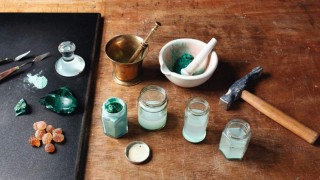Journal 10 April 2018
Alchemy Academy: The Prince’s Foundation School of Traditional Arts
The creation of colour is an age-old craft that has its roots in culture, commerce and religion
Mixing colours is fascinating, whether you’re a child experimenting with colour for the first time or a painter seeking a deeper understanding of how pigments behave. But have you ever considered how the first paints were created and how the first palette came to be?
In an east London art studio, all is about to be revealed. Will Riding, a tutor at The Prince’s Foundation School for Traditional Arts, brings a hammer down on a piece of malachite, an intensely green mineral. Shards of the rock fly across the table and are scooped up into a pestle and mortar to be ground down to make a pigment.
The first paints were created 40,000 years ago, resulting in a palette of red, yellow, brown, black and white. The history of colour has since been one of perpetual discovery. Shimmering yellows were once derived from the urine of mango-fed cows, rich reds were ground from cinnabar, a red sulphide, and ultramarine blue came, and still comes, from the stone lapis lazuli, sourced from one mountain range in Afghanistan and rivalling gold in value.
“Colour was traded on the Silk Road, the ancient trade route linking East and West,” explains Riding. This journey included significant cultural, commercial and religious exchanges. “The Mogao Caves in north west China hold the world’s largest collection of historical Buddhist art, created between the third and 13th centuries,” says Riding. “The Fitzwilliam Museum in Cambridge holds manuscripts from the Church of the Holy Sepulchre, created by Western craftsmen after the First Crusade. Both the cave art and manuscripts contain ultramarine blue.” As spiritual affiliations crossed borders, artists creating kaleidoscopic homages to their gods recounted the progression of society and faith. Art and colour became inextricably linked to the divine.
"A lot of our processes aren't about sight; you have to feel it, hear it"

Colour and its association with the godly existed long before pigments were sold on the Silk Road. Alchemical teaching originated in Egypt 15,000 years ago and taught the link between spirit and matter, where colour represented a spiritual journey from dark to light, moving from the dark tones of plant-derived colour to the light-reflecting properties of silver and gold, linking craft to the sacred. The artist’s studied repetition of the process became meditative, like a form of worship.
This spiritual connection defines the School’s ethos and explains the preparation of colour in the Methods and Materials module of the MA programme. This is also offered as a short course. “A lot of our processes aren’t about sight; you have to feel it, hear it,” explains Riding. He’s right, sound governs this practice. Following the first sharp cracks of Riding’s hammer on stone, your ears soon become used to the vibrations that steer you from one step of the process to the next. Once the broken stone is in the mortar, the sound of the pestle shifts as the fragments become finer. “You then transfer the contents to a ceramic bowl and mix them with water,” says Riding. The sound shifts again into a damp splutter as the pieces soften.
“The water now holds pigment and dirt, so we need to extract the colour. This is done by levigation, which is grinding an insoluble substance into a fine powder while wet,” explains Riding. The solution is poured into jars and left to settle. The pigment slowly falls to the bottom and the remaining fluid is poured off. These steps are repeated until you’re left with a vibrant, fine green powder. Finally, the soft whirring of a glass muller (a weight used for grinding) on marble slab is imperceptible, bonding colour with water or guar gum to create the final paint. The final compound is left to dry in half a mussel shell.
This process is responsible for the creation of many pigments, ink and dyes that have shaped art for centuries. If that’s not magic, I don’t know what is.


